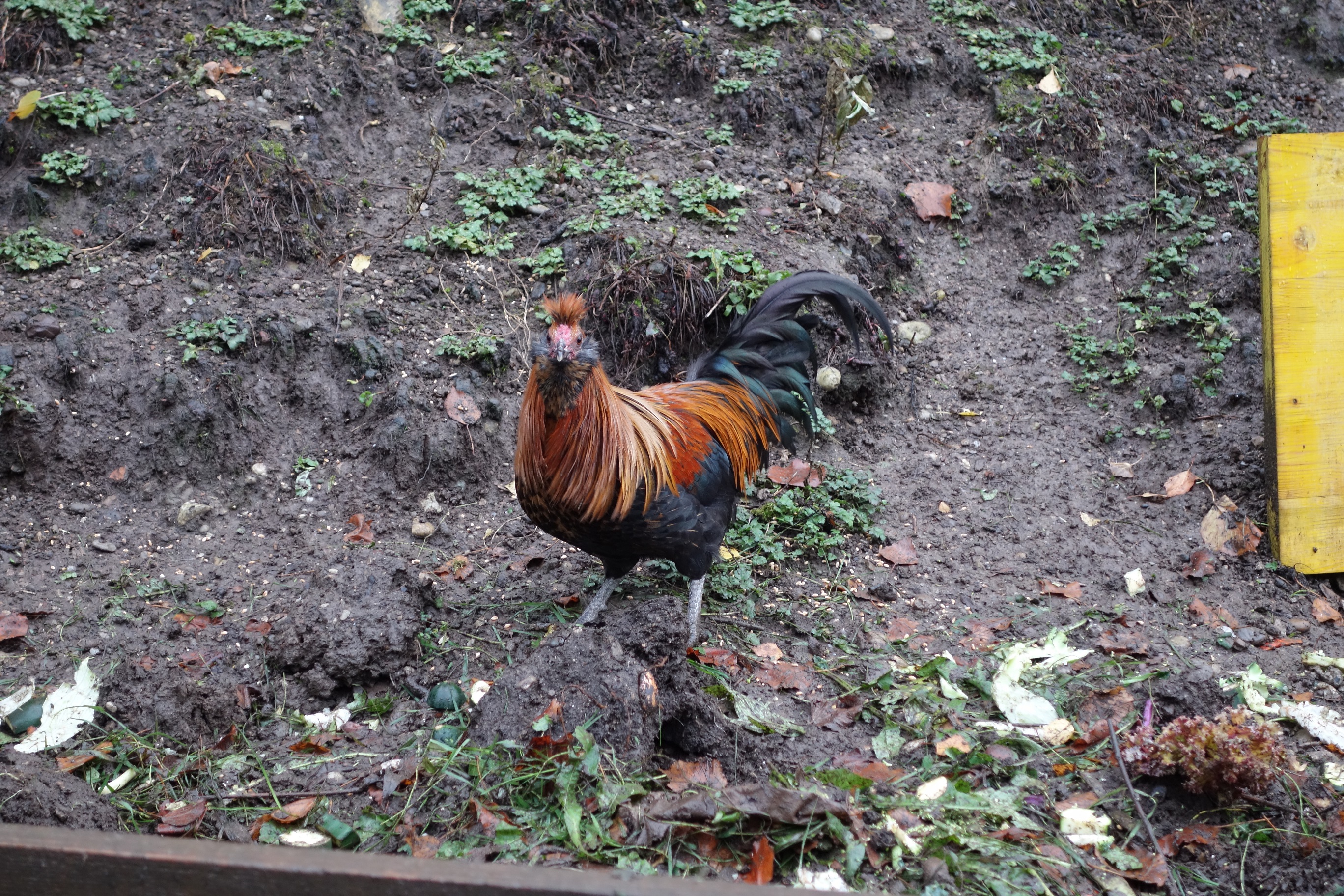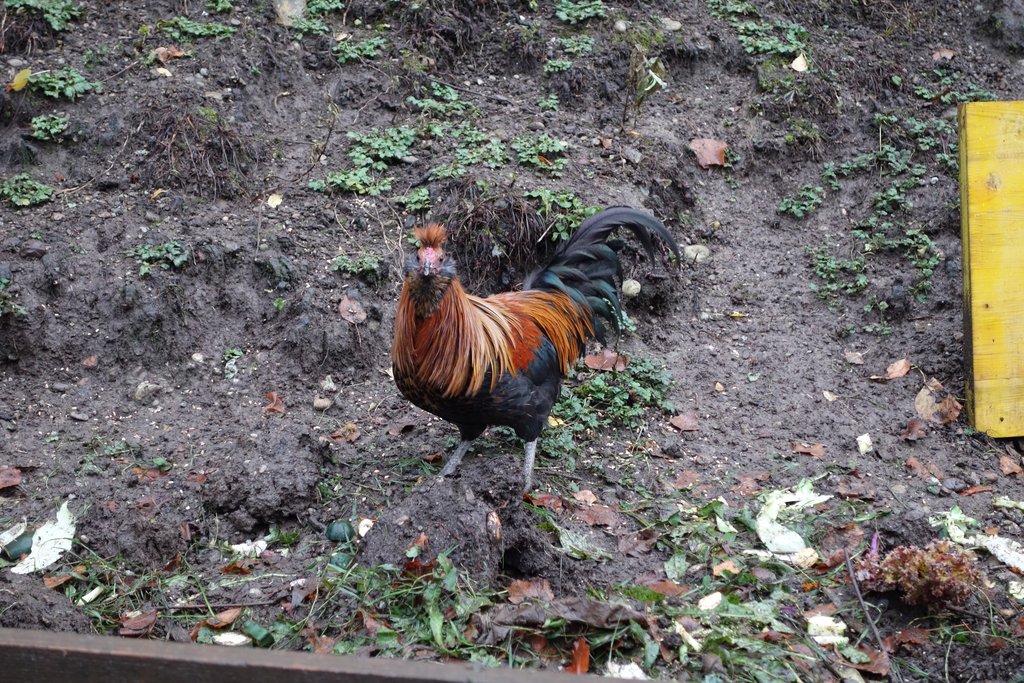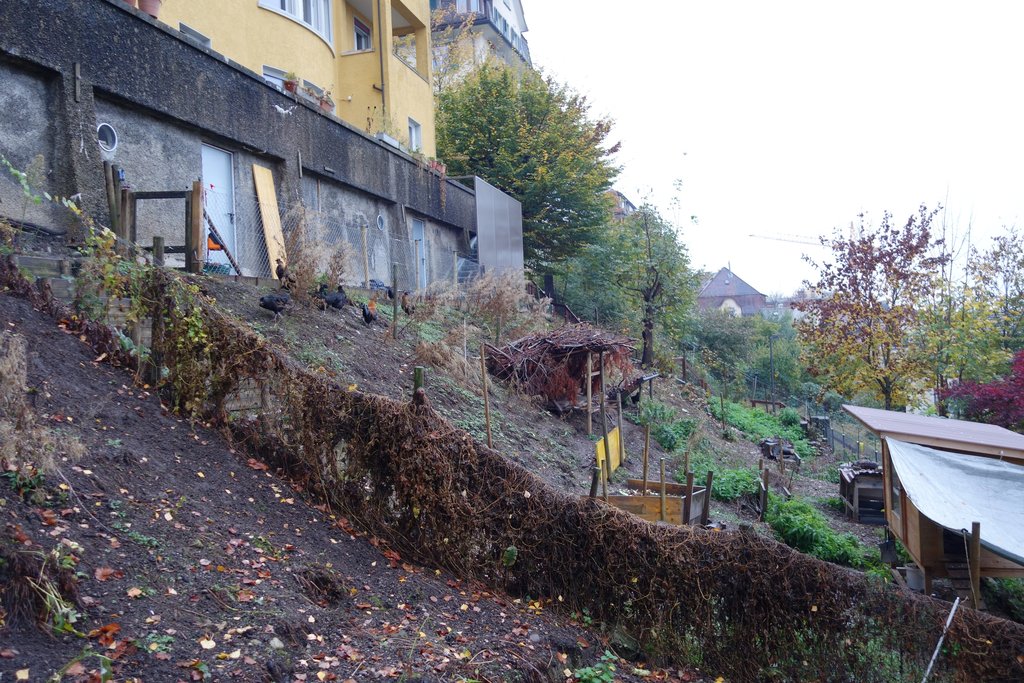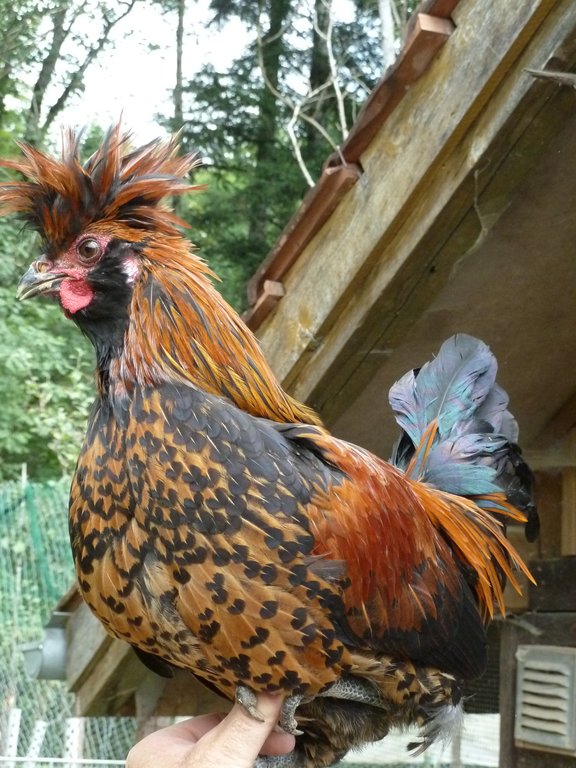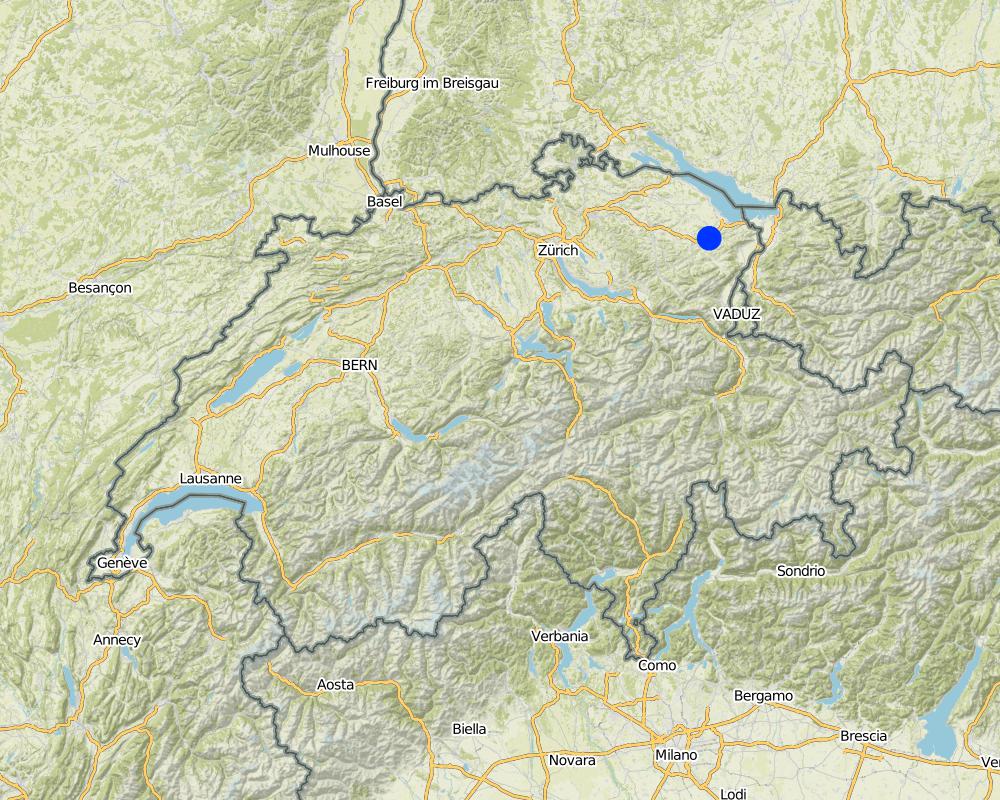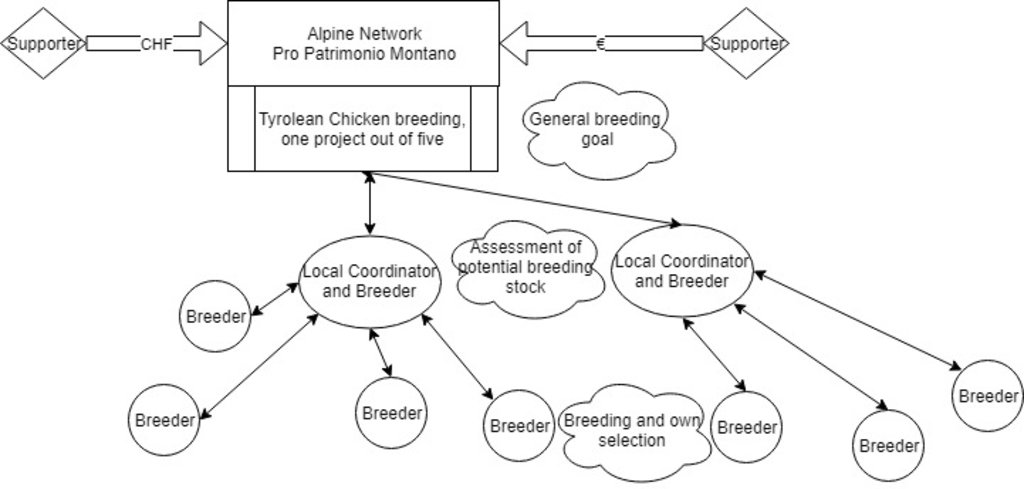Organisation of the breeding for the new Tyrolean Chicken [Suiza]
- Creación:
- Actualización:
- Compilador: Stefan Graf
- Editor: –
- Revisor: Alexandra Gavilano
Zuchtgruppenorganisation für das Neu-Tirolerhuhn
approaches_4165 - Suiza
Visualizar secciones
Expandir todo Colapsar todos1. Información general
1.2 Detalles de contacto de las personas de referencia e instituciones involucradas en la evaluación y la documentación del Enfoque
Persona(s) de referencia clave/s
Especialista MST:
Grünenfelder Hans-Peter
www.patrimont.org
Pro Patrimonio Montano
www.patrimont.org
Suiza
Usuario de la tierra:
Waibel Benjamin
Suiza
Nombre de la(s) institución(es) que facilitaron la documentación/ evaluación del Enfoque si fuera relevante)
Bern University of Applied Sciences, School of Agricultural, Forest and Food Sciences (HAFL) - Suiza1.3 Condiciones referidas al uso de datos documentados mediante WOCAT
¿Cuándo se compilaron los datos (en el campo)?
29/10/2018
El compilador y la/s persona(s) de referencia claves aceptan las condiciones acerca del uso de los datos documentados mediante WOCAT :
Sí
2. Descripción del Enfoque MST
2.1 Breve descripción del Enfoque
A new chicken breed is developed based on three remnants populations having similar looks, with the purpose of recreating a healthy chicken adapted to mounaneous areas.
2.2 Descripción detallada del Enfoque MST
Descripción detallada del Enfoque MST:
Chicken with a crest have been known in the alpine areas of Switzerland, Austria and Italy for many centuries, as bone excavations, historic paintings and old pictures show. Crested chicken can still be found in Switzerland, now called “Appenzeller Spitzhauben, and in north-eastern Italy, as Polverara. Members of the association Pro Patrimonio Montano supposed that these chickens are the southeastern and western remnants of the same population of chicken and wondered what would happen if they crossed the two breeds. In 2010 crosses were done in both ways. As the crossed individuals all turned out black, and quite uniform, the initiators decided to start a serious breeding project with the aim of developing a breed adapted to the alpine conditions while relying only on the genetics of the two former chicken breeds. Later a small population of crested chicken, supposed to be other remnants of the Tyrolean chicken, was found on a remote farm in a remote valley, the Sarntal, and integrated into the breeding project of the “New Tyrolean Chicken”. The roosters of descendants of the Sarntal chicken are quite aggressive, reason why it is not used extensively in the new Tyrolean chicken breed.
The breeding is decentralized, with many small-scale farmers, hobby chicken keepers, and other interested persons keeping breeding groups. The breeders are organized in regional groups, with one regional coordinator overseeing 3 to 7 chicken breeders. The regional coordinator is assessing each newly hatched chicken and rooster to select for the ones being kept for further breeding. Selection takes place for morphological traits to match the ancient type of Tyrolean chicken. The selection for this ancient phenotype is due to the fact that the appenzeller Spitzhauben” has been crossed with other chicken because of concern with inbreeding, as the population was based only on a few individuals.
The regional coordinator is compensated for each chicken he or she assesses with 3 CHF/€, and additionally 2 CHF/€ per ring put on a chicken suitable for breeding. The assessment takes place at around 13 weeks. The assessment is then sent on an excel file to the coordinator at Pro Patrimonio Montano, where all files are added together. Each chicken has its ancestors recorded, with the maternal line being merged as sisters bred together.
Pro Patrimonio Montano is organized as an association, overseeing currently five breed and species of animals. The voting inside the organization for changing rules is done by representants of the breeders. Each region with up to 50 breeders has one voice at votes, can therefore send one representative. Regions with more than 50 breeders have two votes, thus two representatives.
2.3 Fotos del Enfoque
2.5 País/ región/ lugares donde el Enfoque fue aplicado
País:
Suiza
Región/ Estado/ Provincia:
As well as Italy and Austria
Map
×2.6 Fechas de inicio y conclusión del Enfoque
Indique año del inicio:
2010
2.7 Tipo de Enfoque
- iniciativa local reciente/ innovadora
2.8 Propósitos/ objetivos principales del Enfoque
The objective is to breed a healthy chicken for the alpine region, while keeping the old remaining genetics of crested alpine chicken.
2.9 Condiciones que facilitan o impiden la implementación de la/s Tecnología/s aplicadas bajo el Enfoque
normas y valores sociales/ culturales/ religiosos
- facilitan
The keeping of ancient breeds starts to be culturally promoted
colaboración/ coordinación de actores
- facilitan
The fact that different regions have coordinators helps to implement sustainable ways to keep chicken.
políticas
- impiden
As it is a project working over three countries, the legal framework is different in each country. The exchange of bloodlines is also hindered due to this.
conocimiento de MST, acceso a apoyo técnico
- facilitan
The more is known about chicken keeping, the better they can be kept.
mercados (para comprar insumos, vender productos) y precios
- impiden
The chicken Tyrolean chicken cannot compete with the hybrids, even if it lays well compared to other ancient breeds. It is more useful in a smaller setting than on an industrial scale.
3. Participación y roles de las partes interesadas involucradas
3.1 Partes interesadas involucradas en el Enfoque y sus roles
- usuarios locales de tierras/ comunidades locales
Hobby chicken keepers as well as small scale farmers
They breed the chicken, and some breeders are regional coordinators. The regional coordinators assess the new animals to see if they can be kept as breeders or removed from the gene pool.
- ONG
The breeding takes place under the umbrella of the NGO Pro Patrimonio Montano, who is currently overseeing five alpine animal breeds.
Provides the legal framework as an association.
3.2 Involucramiento de los usuarios locales de tierras/ comunidades locales en las distintas fases del Enfoque
| Involucramiento de los usuarios locales de tierras/ comunidades locales | Especifique quién se involucró y describa las actividades | |
|---|---|---|
| iniciación/ motivación | auto-movilización | Two breeders, one of polverara chicken, the other of Appenzeller spitzhauben, decided to see what would happen if the two breeds were crossed. Out of this, the project started. |
| planificación | interactivo | The initiators, being only two, found others with which they could breed the new Tyrolean chicken. |
| implementación | interactivo | As two breeders on a small scale are not enough, others joined. |
| monitoreo y evaluación | interactivo | The egg laying is monitored only by a few chicken keepers. An evaluation of the breeding stock takes place for every animal about to enter the gene pool. |
3.3 Flujograma (si estuviera disponible)
Descripción:
Pro Patrimonio Montano (Patrimont) is the association under which the breeding of the New Tyrolean Chicken takes place. Patrimont is financed by supporters, and is a tax-deductible association in Switzerland.
Patrimont decided on a general phenotype (breeding goal) for the new tyrolean chicken. It does not recognize animals which are outcrossed for a better look or color, as it wants to keep the genetics of the alpine crested chicken.
The breeders, who can be farmers, hobby keepers, or other (zoo...) breed the chicken which are then assessed by a regional coordinator. If they meet the requirements of Patrimont, the breeder can use them for further breeding. Usually, the hens are kept, and the roosters are exchanged or sold. The regional coordinator keep a record on the ancestry of each chick hatched, and coordinate exchange of roosters, even among regional groups.
Autor:
Stefan Graf
3.4 La toma de decisiones en la selección de Tecnología(s) MST
Especifique quién decidió la selección de las Tecnología/ Tecnologías a implementarse:
- principalmente usuarios de tierras con el apoyo de especialistas MST
Explique:
All the chicken keepers chose to breed or not. Regional coordinators help with the selection of the breeding stock.
Especifique las bases que sustentaron la toma de decisiones:
- la evaluación de conocimiento MST bien documentado (la toma de decisiones se basa en evidencia)
- la experiencia personal y opiniones (no documentadas)
4. Apoyo técnico, fortalecimiento institucional y gestión del conocimiento
4.1 Construcción de capacidades / capacitación
¿Se proporcionó la capacitación a usuarios de tierras/ otras partes interesadas?
Sí
Especifique quién fue capacitado:
- personal de campo/ consejeros
Forma de capacitación:
- en el contexto de trabajo
- cursos
Temas avanzados:
Selection of the breeding stock. The training is only for the regional coordinators.
4.2 Servicio de asesoría
¿Los usuarios de tierras tienen acceso a un servicio de asesoría?
Sí
Especifique si servicio proporcionado se realizó:
- en los campos de los usuarios de tierras
Describa/ comentarios:
The advisory service is given by the regional coordinators.
4.3 Fortalecimiento institucional (desarrollo institucional)
¿Se establecieron o fortalecieron instituciones mediante el Enfoque?
- sí, moderadamente
Especifique el nivel o los niveles en los que se fortalecieron o establecieron las instituciones:
- regional
Describa la institución, roles y responsabilidades, miembros, etc.
The regional coordinators were put in place to coordinate the breeding and to advise the chicken keepers.
Especifique el tipo de apoyo:
- construcción de capacidades/ entrenamiento
4.4 Monitoreo y evaluación
¿El monitoreo y la evaluación forman parte del Enfoque?
Sí
Comentarios:
A monitoring and evaluation of the breeding stock only takes place before the onset of the laying. The egg production is only evaluated by a few chicken keepers.
Si respondió que sí, ¿la documentación se utilizará para monitoreo y evaluación?
No
4.5 Investigación
¿La investigación formó parte del Enfoque?
Sí
Proporcione detalles adicionales e indique quién hizo la investigación:
The project started as an experiment to research what would happen if the Polverara and the Appenzeller Spitzhauben chicken were crossed.
5. Financiamiento y apoyo material externo
5.1 Presupuesto anual para el componente MST del Enfoque
Si no se conoce el presupuesto anual preciso, indique el rango:
- < 2,000
Comentarios (ej. fuentes principales de financiamiento/ donantes principales):
Mainly donations via the association Pro Patrimonio Montano.
In the early years of the project, the budget was higher due to the necessary animal transports.
5.2 Apoyo financiero/material proporcionado a los usuarios de tierras
¿Los usuarios de tierras recibieron financiamiento/ apoyo material para implementar la Tecnología/ Tecnologías? :
No
5.3 Subsidios para insumos específicos (incluyendo mano de obra)
- otro
| Otro (especifique) | En qué grado | Especifique los subsidios |
|---|---|---|
| Breeding stock | totalmente financiado | In the beginning of the project, chicken were given free of charge to the keepers, with the condition that they had to give back breeding stock. |
5.4 Crédito
¿Se proporcionó crédito bajo el Enfoque para actividades MST?
No
5.5 Otros incentivos o instrumentos
¿Se usaron otros incentivos o instrumentos para promover la implementación de Tecnologías MST?
No
6. Análisis de impacto y comentarios de conclusión
6.1 Impactos del Enfoque
¿El Enfoque movilizó/mejoró el acceso a recursos financieros para implementar MST?
- No
- Sí, un poco
- Sí, moderadamente
- Sí, mucho
As there is an association behind the breeding of the tyrolean chicken, the regional coordinators get a small compensation for the assessment of the breeding stock.
¿El Enfoque mejoró el conocimiento y capacidades de otras partes interesadas?
- No
- Sí, un poco
- Sí, moderadamente
- Sí, mucho
The regional coordinators are trained to assess the potential breeding stock.
¿El Enfoque construyó/ fortaleció instituciones, colaboración entre partes interesadas?
- No
- Sí, un poco
- Sí, moderadamente
- Sí, mucho
The regional coordinators help the chicken keepers in their region.
¿El Enfoque resultó en mejor seguridad alimentaria/ mejoró la nutrición?
- No
- Sí, un poco
- Sí, moderadamente
- Sí, mucho
As biodiversity of the food base, the chicken in this case, is important for future food security, the in-situ conservation of other breeds counters the loss due to the concentration of the breeding of livestock.
6.2 Motivación principal del usuario de la tierra para implementar MST
- prestigio, presión social/ cohesión social
The Tyrolean chicken looks better than a random hybrid chicken.
- conciencia medioambiental
The loss of biodiversity and the need to breed locally is a factor for some breeders.
- mejoramiento estético
The Tyrolean chicken looks more interesting than the laying hybrids.
6.3 Sostenibilidad de las actividades del Enfoque
¿Pueden los usuarios de tierras sostener lo que se implementó mediante el Enfoque (sin apoyo externo)?
- sí
6.4 Fortalezas/ ventajas del Enfoque
| Fuerzas/ ventajas/ oportunidades desde la perspectiva del usuario de la tierra |
|---|
| The organisation is adapted to the need of the breeders. |
| Fuerzas/ ventajas/ oportunidades desde la perspectiva del compilador o de otra persona de referencia clave |
|---|
| Knowledge is spread about the conservation of genetic resources and backyard poultry keeping. |
6.5 Debilidades/ desventajas del Enfoque y formas de sobreponerse a ellos
| Debilidades/ desventajas/ riesgos desde la perspectiva del compilador o de otra persona de referencia clave | ¿Cómo sobreponerse a ellas? |
|---|---|
| The new Tyrolean Chicken is not assessed for the egg laying, and can therefore not be selected for it. | Subsidise automatic electronic egg traps, for example based on RFID chips on chicken legs. |
| The new Tyrolean chicken may replace other rare breeds. | The biggest threat to biodiversity is industrial agriculture, therefore the promotion of other initiatives like the new Tyrolean chicken can counter this loss of biodiversity. The new Tyrolean chicken complements the other available breeds. |
7. Referencias y vínculos
7.1 Métodos/ fuentes de información
- visitas de campo, encuestas de campo
Three chicken keepers were asked
- entrevistas con usuarios de tierras
- entrevistas con especialistas/ expertos en MST
One of the initiants of the project.
7.2 Referencias a publicaciones disponibles
Título, autor, año, ISBN:
Agricultural Genetic Resources in the Alps, Monitoring Institute for Rare Breeds and Seeds in Europe, 2003, ISBN 3-258-06669-8
¿Dónde se halla disponible? ¿Costo?
Available from Pro Patrimonio Montano
7.3 Vínculos a la información relevante disponible en línea
Título/ descripción:
Pro Patrimonio Montano
URL:
patrimont.org
Título/ descripción:
An RFID-Based Smart Nest Box: An Experimental Study of Laying Performance and Behavior of Individual Hens
URL:
https://www.ncbi.nlm.nih.gov/pubmed/29538334
Título/ descripción:
Umwelt und Artgerechte Legehennenhaltung. Entwicklung und Erprobung von elektronischen Registrierungssystemen. Ab S. 99
URL:
https://docplayer.org/63001785-High-tech-innovationen-fuer-verfahrensketten-der-agrarproduktion.html
Título/ descripción:
Trial with automatic egg count
URL:
https://www.cabi.org/Uploads/animal-science/worlds-poultry-science-association/WPSA-italy-2006/10204.pdf
Vínculos y módulos
Expandir todo Colapsar todosVínculos
No hay vínculos
Módulos
No se hallaron módulos


